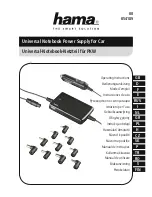
Setting Up a Healthy Work Environment A-3
Use the entire seat and backrest to support your body. Tilt the backrest
slightly (90° to 105°). The angle formed by your thighs and back should
be 90° or more.
Your seat depth should allow your lower back to comfortably contact the
backrest. Make sure that the backs of your lower legs do not press
against the front of the chair.
Extend your lower legs slightly so that the angle between your thighs and
lower legs is 90° or more.
Place your feet flat on the floor. Only use a footrest when attempts to
adjust your chair and workstation fail to keep your feet flat.
Be sure that you have adequate clearance between the top of your thighs
and the underside of your workstation.
Use armrests or forearm supports to support your forearms. If adjust-
able, the armrests or forearm supports should initially be lowered while
all the other adjustments discussed in this appendix are made. Once all
these adjustments are completed, raise the armrests or adjust the forearm
supports until they touch the forearms and allow the shoulder muscles to
relax.
ADJUST YOUR INPUT DEVICES
Note the following points when positioning your notebook computer or any
external input devices.
Position your keyboard directly in front of you. Avoid reaching when
using your keyboard or mouse.
If you use a mouse, position it at the same height as the keyboard and
next to the keyboard. Keep your wrists straight and use your entire arm
when moving a mouse. Do not grasp the mouse tightly. Grasp the mouse
lightly and loosely.
Adjust the keyboard height so that your elbows are near your body and
your forearms are parallel to the floor, with your forearms resting on ei-
ther armrests or forearm supports, in the manner described previously. If
you do not have armrests or forearm supports, your upper arms should
hang comfortably at your sides.
Adjust the keyboard slope so that your wrists are straight while you are
typing.
Содержание VERSA 6200MX - SERVICE
Страница 185: ...Index 5 Y Y adapter 4 41 Y cable adapter 1 8 ...
















































